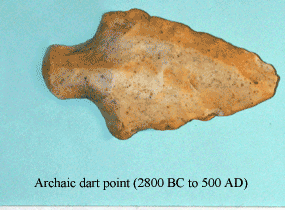
NPS photo No one knows who the first native Americans to set foot on Padre Island were. By best estimates, the first people to inhabit the area now known as South Texas arrived around 10,000 B.C. The best estimate for the age of the island however, is 3,000 to 5,000 years, meaning the island formed sometime around 3,000 B.C. at the earliest. Recent analysis of native American points (i.e. arrowheads, spear points, knife blades, etc.) found on the island indicates the island has probably been visited, if not inhabited, by native Americans since its formation. The peoples who most recently inhabited the coast of South Texas were the Coahuiltecans and the Karankawas. Both were groups of interrelated nomadic hunter-gatherer bands that roamed the coast and inland for some distance. In general, the Karankawa ranged within the area between Corpus Christi Bay and Galveston and the Coahuiltecans generally ranged within the area from Corpus Christi Bay south into Mexico. However, please note that these areas are only broad approximations. Both peoples often wore little, if any, clothing and usually decorated themselves with tattoos and body piercings. The bands, usually consisting of a single family, were related linguistically and culturally, but otherwise probably had few ties. Each band wandered the country foraging for food on its own and probably seldom came together with other bands of its tribe, except by accidental meeting. Bands usually moved from place to place depending upon where they knew they could find food. Both peoples lived off deer, small game, rodents, and even insects, but their main food sources were probably plants such as prickly pear cactus, mesquite beans, and pecan. Bands from both the Coahuiltecans and Karankawa would sometimes come out to Padre Island to live off the game, fish, and abundant shellfish. Describing the Coahuiltecans and Karankawas is difficult, because customs could vary widely between bands of what we consider the same people. Very little is known about the Coahuiltecans and the name of the group is a generalization. "Coahuiltecan" is a name used by archeologists to refer to the various bands of people that wandered in an area between present-day San Antonio and northern Mexico. The Spanish who colonized the area left few records of the Coahuiltecan people or their language or languages. It is probably best to say that the bands of the Coahuiltecan were probably related by language. Some bands of the Coahuiltecans were known to number into the hundreds. The Coahuiltecans usually built circular huts of a wooden framework, such as willow, and covered it with animal skins or matting. They would hunt with bow and arrow, but usually kept a club nearby for self defense. One of the Coahuiltecan bands was known as the Malaquites (often seen on Spanish maps as Malaquitas or Malaquittas or even Malaguittas) and is the band for whom the Malaquite beach section of the National Seashore is named. A map drawn by Colonel Diego Ortiz Parrilla, who scouted the island for Spain in 1766, shows several Malaquite settlements on the southern end of the island while a Karankawa settlement and two other bands are noted on the northern end. More is known of the Karankawa, who existed as a people in Texas until about 1850. The Karankawas lived in the same nomadic lifestyle as the Coahuiltecans, living in small bands, hunting with bow and arrow, eating whatever was available, and living in huts made of a simple wooden framework covered by skins or mats. Because the Karankawas were mainly a coastal people, they often traveled by dugout canoe. The Karankawas were noted for being tall (between 6'-7'), excellent archers, and ferocious in appearance. They also a somewhat undeserved reputation as cannibals, based on a religious ceremony taking place after a victorious battle, in which an enemy captive was at least partially consumed. Otherwise, the Karankawas were apparently as repulsed by the idea of eating other humans as modern people are. The Karankawa never adapted to the new ways of the European settlers as well as many other peoples did. Their population was decimated by intermittent warfare with them and by the new diseases which had been introduced. |
Last updated: October 2, 2021
